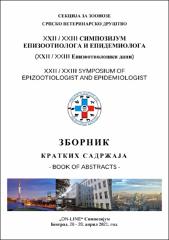Nalaz Hantavirusa Dobrava kod mišolikoh glodara na području Vojvodine

View/
Date
2021-04-26Author
Petrović, Tamaš
Savić, Sara
Vidanović, Dejan
Lazić, Gospava
Samojlović, Milena
Lupulović, Diana
Lazić, Sava
Bjelić Čabrilo, Olivera
Metadata
Show full item recordAbstract
Hantaviruses are viruses transmitted by rodents that cause clinical diseases in people of varying severity. There are several different types of hantaviruses with different geographical distribution and causing different clinical diseases. Each hantavirus is specific to a different rodent host. The virus is transmitted to humans by inhaling the urine, feces or saliva of an infected rodent. After hantavirus infection, three main clinical syndromes can be distinguished: hemorrhagic fever with renal syndrome (HFRS), mainly caused by the Seoul, Puumala, and Dobrava viruses; epidemic nephropathy, a mild form of HFRS caused by the Puumala virus; and hantavirus cardiopulmonary syndrome caused by Sin Nombre virus and several others.
Since the fall of 2019, research has been conducted on the presence and prevalence of hemorrhagic fever virus (Hanta virus Dobrava) in natural hosts - mouse-like rodents in both urban and forest / field areas in the vicinity of City of Novi Sad. In the period from August 28th, 2019 to July 7th, 2020, 17 field trips were conducted to 8 localities. The localities included habitats where it is possible for humans and domestic animals to come into contact with wild rodent populations, ie where the environment could be contaminated with pathogens carried by these animals. In total, 137 individuals of seven different rodent species were caught whose organ samples (kidney, lung and liver) were tested for the presence of Hantavirus Dobrava - Belgrade (DOBV) by TaqMan real-time RT-PCR method according to the previously established protocol. The presence of DOBV was confirmed in 10 individuals, namely in the following species: Apodemus agrarius (in 3 individuals from Kamenjara, Novi Sad, 1 individual in the area of Dunavc Sremski Karlovci and 2 individuals from Koviljski rit); A. sylvaticus (1 individual from Kamenjara, Novi Sad, and 1 individual from Irish Wreath), A. flavicollis (1 individual from Koviljski rit) and Micromys minutus (1 individual from Koviljski rit). The virus is most often detected in the kidneys, then in the lungs and liver of rodents.
The obtained findings indicate the existence of critical hot spots - endemic areas of hantavirus in the Vojvodina Province. At the same time, the obtained results indicate the need to establish a program method of monitoring (monitoring or surveillance) the presence of hantavirus DOBV and other hemorrhagic fever viruses in Vojvodina, to determine the prevalence of hantaviruses and epidemiological predictions (monitoring and prevention) of possible zoonotic infections and epidemics in humans.
